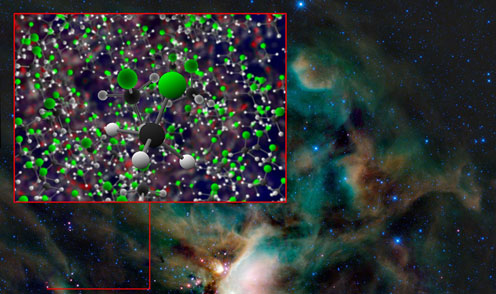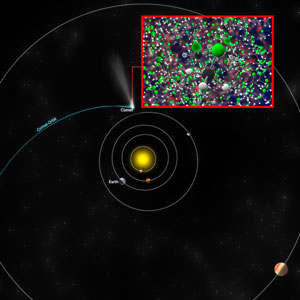ALMA and Rosetta Detect Freon-40 in Space
Observations made with the Atacama Large Millimeter/submillimeter Array (ALMA) and ESA’s Rosetta mission by an international team, including researchers from the Niels Bohr Institute, have revealed the presence of the organohalogen Freon-40 in gas around both an infant star and a comet. Organohalogens are formed by organic processes on Earth, but this is the first ever detection of them in interstellar space. This discovery suggests that organohalogens may not be as good markers of life as had been hoped, but that they may be significant components of the material from which planets form. This result, which appears in the journal Nature Astronomy, underscores the challenge of finding molecules that could indicate the presence of life beyond Earth.

Organohalogen methyl chloride discovered by ALMA around the infant stars in IRAS 16293-2422. These same organic compounds were discovered in the thin atmosphere surrounding 67P/C-G by the Rosetta space probe. Credit: B. Saxton (NRAO/AUI/NSF); NASA/JPL-Caltech/UCLA
Dashing Hopes that Molecule May be Marker of Life.
Using data captured by ALMA in Chile and from the ROSINA instrument on ESA’s Rosetta mission, a team of astronomers has found faint traces of the chemical compound Freon-40 (CH3Cl), also known as methyl chloride and chloromethane, around both the infant star system IRAS 16293-2422 [1], about 400 light-years away, and the famous comet 67P/Churyumov-Gerasimenko (67P/C-G) in our own Solar System. The new ALMA observation is the first detection ever of a stable organohalogen in interstellar space [2].
Organohalogens consist of halogens, such as chlorine and fluorine, bonded with carbon and sometimes other elements. On Earth, these compounds are created by some biological processes — in organisms ranging from humans to fungi — as well as by industrial processes such as the production of dyes and medical drugs [3].
This new discovery of one of these compounds, Freon-40, in places that must predate the origin of life, can be seen as a disappointment, as earlier research had suggested that these molecules could indicate the presence of life.
“Finding the organohalogen Freon-40 near these young, Sun-like stars was surprising,” said Edith Fayolle, a researcher with the Harvard-Smithsonian Center for Astrophysics in Cambridge, Massachusetts in the USA, and lead author of the new paper. “We simply didn't predict its formation and were surprised to find it in such significant concentrations. It’s clear now that these molecules form readily in stellar nurseries, providing insights into the chemical evolution of planetary systems, including our own.”

Approximate location of comet 67P/C-G when the Rosetta space probe discovered traces of methyl chloride -- the same molecule detected by ALMA around the IRAS 16293-2422 star-forming region. Credit: B. Saxton (NRAO/AUI/NSF)
Exoplanets and chemical markers
Exoplanet research has gone beyond the point of finding planets — more than 3000 exoplanets are now known — to looking for chemical markers that might indicate the potential presence of life. A vital step is determining which molecules could indicate life, but establishing reliable markers remains a tricky process.
“Although, it may at first appear disappointing that methyl chloride cannot be used as a biomarker, the ALMA discovery is still an important result. The chemistry of the dense cold clouds may represent the starting conditions for organic chemistry on planets and thus perhaps an important step toward the origins of life,” adds Jes Jørgensen from the Niels Bohr Institute at University of Copenhagen, leader of the ALMA survey and co-author on the study. “The results therefore provide valuable insight into the so-called ‘primordial soup’, both on the young Earth and on nascent rocky exoplanets.”
This suggests that astronomers may have had things around the wrong way; rather than indicating the presence of existing life, organohalogens may be an important element in the little-understood chemistry involved in the origin of life.
Jes Jørgensen adds: "This result shows the power of ALMA to detect molecules of astrobiological interest toward young stars on scales where planets may be forming. Using ALMA, we have previously found precursors to sugars and amino acids around different stars. The additional discovery of Freon-40 around Comet 67P/C-G strengthens the links between the pre-biological chemistry of distant protostars and our own Solar System."
The astronomers also compared the relative amounts of Freon-40 that contain different isotopes of chlorine in the infant star system and the comet — and found similar abundances. This supports the idea that a young planetary system can inherit the chemical composition of its parent star-forming cloud and opens up the possibility that organohalogens could arrive on planets in young systems during planet formation or via comet impacts.
“Our results show that we still have more to learn about the formation of organohalogens,” concludes Fayolle. “Additional searches for organohalogens around other protostars and comets need to be undertaken to help find the answer.”

Jes Jørgensen, Associate Professor in Astrophysics and Planetary Science at the Niels Bohr Institute and the Centre for Star and Planet Formation at the University of Copenhagen, +45 3532-4186, jeskj@nbi.ku.dk
Topics
See also:
More information
|
Notes
|
